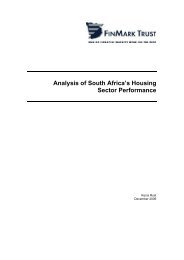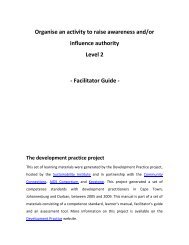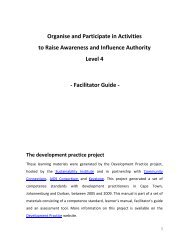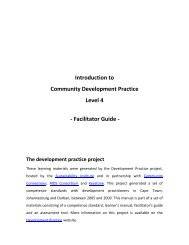the struggle for integrated sustainable settlements.
the struggle for integrated sustainable settlements.
the struggle for integrated sustainable settlements.
Create successful ePaper yourself
Turn your PDF publications into a flip-book with our unique Google optimized e-Paper software.
CASE STUDY<br />
Sandbag houses, Mitchell’s Plain<br />
Sandbag houses have been erected in Freedom Park, Mitchell’s Plain using eco-beam technology,<br />
and 10 more units are planned. They were designed by MMA Architects, Cape Town, as a Design<br />
Indaba project which won an international innovative design award from <strong>the</strong> University of Kentucky,<br />
College of Design. The eye-catching 52m² double-storey houses have a living area and kitchen on <strong>the</strong><br />
ground fl oor, two bedrooms upstairs, and a balcony that can be turned into ano<strong>the</strong>r room. They cost<br />
less than <strong>the</strong> government full housing subsidy of R43 000.00 <strong>for</strong> construction of <strong>the</strong> top structure.<br />
Photos: Pierre Roux<br />
Adobe brick building<br />
Adobe bricks are made of earth, water and dried in <strong>the</strong> sun. They can be made in various ways, depending<br />
on <strong>the</strong> local climate, site, available materials, tools and labour.<br />
Mc Hendry, a Mexican architect in Kennedy (2002) provides <strong>the</strong> following guidance:<br />
“The simplest way is with a single mould. Mud is mixed and placed in <strong>the</strong> moulds by hand on a smooth surface.<br />
The mould is removed and <strong>the</strong> bricks allowed to dry suffi ciently to stand on edge, after which <strong>the</strong>y are trimmed<br />
and allowed to dry completely be<strong>for</strong>e stacking or use.<br />
The whole process takes about one week in most favourable dry climates. The brick making process can be<br />
expanded with <strong>the</strong> use of shovels, wheelbarrows, multiple <strong>for</strong>ms, front-end loaders and concrete or plaster<br />
mixers. The use of a hydraulic pressing machine that can create a large number of bricks (compressed earth<br />
blocks) – up to 4,000 a day – is ano<strong>the</strong>r option.<br />
Once <strong>the</strong>y are dry, adobe bricks are stacked to make walls. The bricks are cemented toge<strong>the</strong>r with a mud<br />
mortar made up of water and screened soil taken from <strong>the</strong> same sources as <strong>the</strong> soil used to make <strong>the</strong> bricks.<br />
…. Adobe walls should be built on a foundation of concrete or stone to protect <strong>the</strong>m from moisture damage.<br />
Frames <strong>for</strong> windows and doors are set in place as <strong>the</strong> wall goes up.”<br />
page 35








